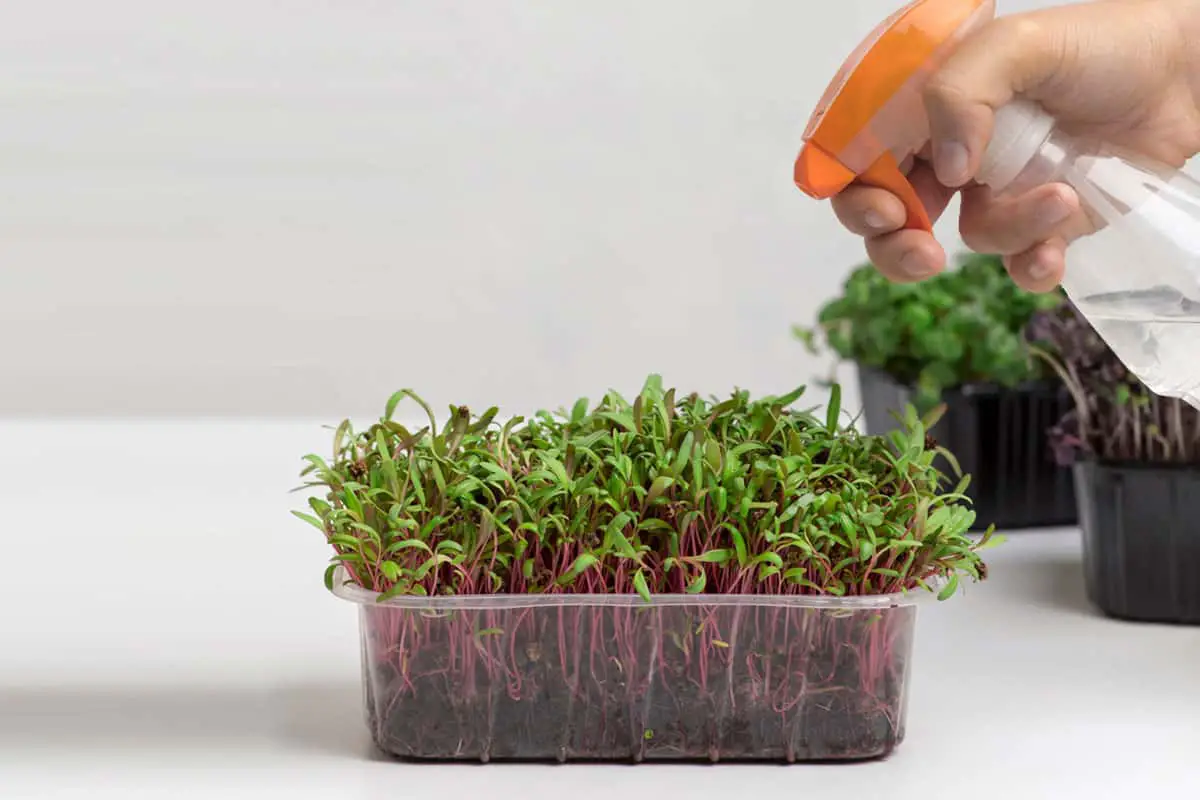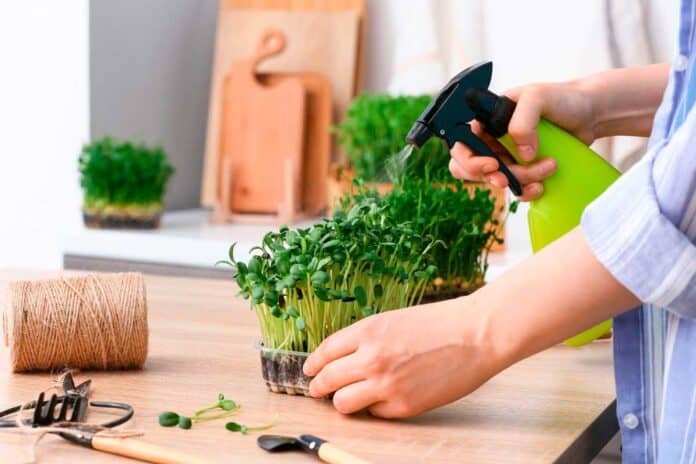Growing your own microgreens is fun and rewarding. These mini veggies are full of wonderful flavors, and they pack quite the punch with nutrients.
However, if you are not caring for your microgreens the way you should be, you could be in for a surprise. And not the good kind.
More and more people are discovering the joy of growing microgreens at home, and even though it is known as easy gardening, there are certainly challenges to it!
Caring for your microgreens does not require intense daily care for them to flourish and give you a great harvest, but they do need your attention. In this guide, we cover all the essentials for how to manage your microgreens from planting to harvest. Following a few simple steps will ensure you’re enjoying the greens of your labor in no time.
Follow the tips above, and you will be more likely to succeed with growing your own superfood. Let’s get into the details. Continue reading this guide to learn how to care for your microgreens. It includes key points for growing a healthy and plentiful harvest.
Microgreen Growing At Home: Easy, Small Tips That Make A Big Impact
The microgreen is like the baby versions of humans in the veggie world; they need particular care tips and methodologies to come out as desirable as ever. It does not matter if you want to sell them or grow them for your own consumption — these tips help microgreen enthusiasts grow their dream microgreens.
Respect Seed Density
Most of the microgreens you see on the internet may feel like someone just slapped them together, and voila! Now you have a fully functioning microgreen growing system. Easy as that, right? The truth is a bit more complicated than that. Seed density for microgreens can vary significantly depending on what type of microgreen you are growing. What is important is to not overseed and not to use too few seeds. So how do you find that right balance?
When you purchase seeds, you can most often find recommendations on seed density on the package. If not, you can use resources shared by other experienced farmers. We have also included in our Microgreens Types pages, guidelines on seed density. This can help you get the right amount for a successful result.
The average seed weight for a 10/20 tray is 1 oz. But again, this can vary depending on the type of seeds, so always make sure that you check before you start to sprinkle them on your growing medium!
TIPS: Use a scale to measure the volume of seeds you need before you start to sprinkle them. That way you make sure to use the right amount.
Keep The Right Temperature And Humidity Level
Humidity and keeping the right temperature are a necessity for plants and microgreens to thrive. When it comes to microgreens, these two factors are what are causing more problems for growers, such as uneven growth, mold, fungus, and poor germination.
You must ensure that they are grown at the right temperature and humidity level. So what does it mean? The best temperature for growing microgreens is at 70° F (21° C). This is actually also considered a good room temperature for comfortable living. Try keeping this temperature all year round in the room where you are growing microgreens.
If the temperature varies too much, you are likely to end up having to deal with problems. As mentioned, these include but are not limited to mold, microgreens starting to smell, and overall your greens may end up bad before you are ready for harvest.
Getting the correct humidity (RH) is also essential when growing your microgreens. They do best with humidity levels of 40-60. Increasing the humidity is not beneficial to your microgreens. Higher levels can cause the same issues as with incorrect temperatures. On top of this, you can also struggle with disease and pest issues. These problems can be difficult to get rid of and can be quite an annoyance.
With small means and adjustments, you can easily overcome these problems. Read our indebt article about how to control humidity and temperature in microgreens.
Keep Out Of Direct Sunlight
Microgreens need light to grow, the same as any other plant or vegetable. Initially, they will spend a couple of days in the dark to allow for germination. This stage of the growth life cycle is called the blackout period. As the seeds have started to grow roots and the stem is stretching upwards, they need light. If you are growing at home, find a location that gets at least six to eight hours of sunlight. The ideal cycle many growers are successful with is giving microgreens 12-15 hours of light a day and around 9-12 hours of darkness. Depending on where you live, it can be impossible to give your microgreens natural sunlight all year around. This is the reason many home growers are investing in grow lights.
If you do not want to use grow lights, you can most definitely use the sun as your resource for light. You should, however, be conscious to not put the container or tray in a window sill if the sunbeams are hot and shining straight at it. Too much heat can cause the microgreens to dry out.
Learn more about light and the importance of getting it right!
- Microgreens Lighting Guide: Choosing Lights And Setting Them Up
- When Should You Expose Microgreens To Light?
- Do Grow Lights Provide Heat Too?
Give Right Amount Of Water
Water is a key element used for growing microgreens! The challenge is to understand how much they need daily. Giving your microgreens too much or too little, can cause a crop to fail.

A general thumb of rule is to water twice a day. Check your microgreens once in the morning and once in the evening. You should always ensure that you are not soaking your microgreens and the growing medium, but instead always keeping it moist. You can do this by initially spraying your seeds with a spray bottle, and then when the roots have developed, you can switch to what is called the “bottom-up” watering method.
“Bottom-up watering means that you are watering your plants from underneath, giving water directly to the roots. When you water them from the bottom up, the roots get stronger because they are growing directly down toward the moisture.”
If you want to dig deeper into how to water your microgreens, we have a full article on the topic!
Use Sharp Scissors Or Knife To Cut
This is the most exciting time of all! When your microgreens are ready for harvest, you must use scissors or a sharp knife to cut them. Ripping them out with your hands will disturb the roots of your plant. Similarly, you will also end up with parts of the plant that is not edible – the roots.
Once your microgreens are ready for harvest, get your scissors or knife out, and cut away! Either tool you chose to use, make sure to use a sharp one! You will quickly notice that if you have a dull scissor or knife, you will struggle to cut your microgreens evenly. Instead of gliding through the microgreens, you are likely to end up crushing the stems.
Store Dry And Enjoy Soon After Harvest
After you have cut the entire crop, ensure to place them (dry) in a sealed container. We recommend eating your microgreens within the next few days to enjoy them fresh. Microgreens do not have a long shelf life. But who will really leave microgreens hanging around for days when you can enjoy their great taste? We know that we don’t. Eat them fresh after harvest and always have lots growing.
Inspect Them Daily
Your microgreens require care similar to all other things we grow. You should make it a habit of doing a daily check-in to see that your microgreens grow healthy. A good practice is to check in on your crops at least once but even better twice a day (required for watering). Having a regular schedule allows you to notice if any problems should arise.
Check:
- if mold is forming
- if your microgreens have enough water
- if the lighting is efficient
- if there is good air circulation
One of the more common problems when growing microgreens, as you have read in this article, is growing mold. Mold has a tendency to grow on microgreens when they have been overwatered and when the temperature, humidity, or airflow is not right. All of these factors could ruin your crop.
Summary
Today we learned the importance of taking care of your microgreens. There is work involved, but it is not hard work. You just have to keep on a schedule with them and look out for things that can damage your crop like overwatering, pests, diseases, etc.
As we started to grow microgreens we faced many of these problems mentioned, but with practice, adjustments, and constant care, we have overcome them. Watching your microgreens go from seed to plant is amazing and rewarding. You will end up with a beautiful mini veggie full of great taste and jam-packed with nutrition!
Frequently Asked Questions
Misting your microgreens is a good way to water them. By misting microgreens you will be less likely to overwater them and the water will be spread around the greens evenly instead of piling at the bottom of their tray.
Microgreens are water hoggers, so it is essential to ensure that your microgreens have appropriate amounts of water throughout the day. Although there are no concrete numbers as to how much you should water your microgreens, it is a good rule of thumb to water them once or twice a day. However, for a more contextual approach, you should check if the soil used for your microgreens is dry; if in the instance that it is, you should water it.
Microgreens are not supposed to be confused with is baby greens, which are typically larger than microgreens. Moreover, like baby greens, sprouts are also different. Sprouts are seeds that have just begun to grow and still have their cotyledons (or “seed leaves”) while microgreens are harvested just after their first true leaves have formed.


